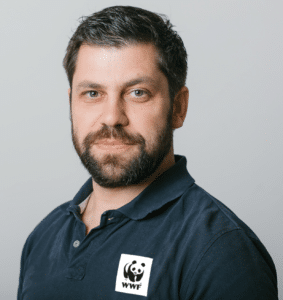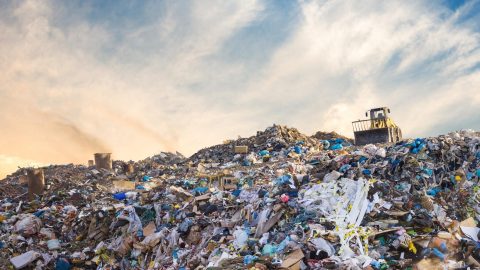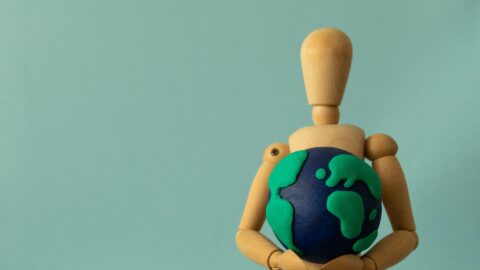Interview with Axel Hein, marine expert at WWF Austria.
Mr. Hein, where does the plastic waste in the oceans come from? Which rivers are the most important sources of plastic pollution?
Hein: Among the most significant causes for the introduction of plastic waste into the oceans are the widespread use of disposable plastic and the lack of structures for collecting and further processing of waste. Significantly less than 50 percent of waste is collected in emerging and developing countries. As a result, the garbage piles up on land especially in Southeast Asia, and is flushed into the sea from rivers (such as Yangtze, Ganges, Irrawaddy, Mekong, etc.).
Why is plastic recycled only to a small extent and how can packaging be made more recyclable?

Axel Hein, WWF; (c) bright light photography
Hein: The reason for this is above all that garbage collection, disposal and recycling often cannot be publicly funded due to lack of funds and private companies do not participate in the financing. A large proportion of people in affected countries can therefore not dispose of their waste properly; they just lack the infrastructure for it.
To stop the global flood of plastics, a global movement is needed that challenges politics and business to become part of the solution. It needs better packaging and less useless plastic. It needs rules for better waste management and effective measures to protect the seas and coasts.
The development of a circular economy is considered important in this context: how realistic is this feasible or can certifications help?
Hein: It must be ensured at the global level that all waste, if it cannot be avoided from the outset, is completely collected and recycled in a circular economy. But a functioning waste management and the development of a circular economy would first have to be built up. This usually fails because of insufficient financing for the necessary investments as well as for running costs.
In many European countries, the consumer goods industry and commerce now have to contribute to the packaging disposal costs. Therefore, in emerging and developing economies, businesses must also take responsibility for the products and packaging placed on the market and contribute to the disposal costs incurred.
How can consumers help reduce plastic waste?
Hein: Consumers can do a lot to reduce their plastic waste:
They can refrain from using disposable plastic products, such as coffee cups, bottles, straws, etc.
- Avoid as much as possible disposable bags and disposable tableware while on holiday in other countries
- Support a circular economy and separate waste properly or
- Participate in cuommunity clean-up actions.
“Bioplastics” – can these contribute to relief or are there risks?
Hein: One possible solution to the problem of marine litter is to improve the recyclability of packaging or to test the use of biodegradable plastics for specific applications (sanitary products, catering utensils). In the spectrum of so-called bioplastics, there are a few materials where biodegradation is possible in relatively short periods of time compared to conventional plastics. This approach is not uncontroversial.
Some fear that this will support the throw-away mentality. Moreover, it is not yet scientifically certain whether these plastics are actually degraded under conditions that prevail in the sea. Following the concept of “Cradle to Cradle”, it can make sense to create two strictly separate cycles: on the one hand from material that remains in the technosphere (recycling) and on the other hand from material that remains in the biosphere (use and subsequent composting and recycling) Decomposition).
The EU Commission plans to ban ten plastic disposable products, which cause 70% of all waste in the sea. How useful is this prohibition, according to the WWF and which steps would be necessary?
Hein: This EU directive is a necessary step that specifically refers to the plastic products most commonly found in the sea. Addressing disposable plastic directly is important, but with the focus on disposable items from the catering industry, the EU is only targeting the tip of the iceberg. Europe-wide, clearer signals must be set for the general avoidance of plastic waste and circular economy. It needs clear guidelines in order to improve the recyclability of food packaging and to increasingly produce from recycled material.
From our point of view, the concrete requirements for disposable bottles are pleasing: 90 percent of them need to be collected and recycled by 2025. The approach to obliging manufacturers of disposable cups made of plastic or filter cigarettes to to be held responsible to dispose of their products is a right step.
Plastic pollution is a global problem that we need to find a global answer to. We need a “Paris Agreement for the Ocean” that stops the pollution of the oceans. The EU member states must support the corresponding process of the UNEA.
Legal disclaimer
This document is an advertisement. Unless indicated otherwise, source: Erste Asset Management GmbH. The language of communication of the sales offices is German and the languages of communication of the Management Company also include English.
The prospectus for UCITS funds (including any amendments) is prepared and published in accordance with the provisions of the InvFG 2011 as amended. Information for Investors pursuant to § 21 AIFMG is prepared for the alternative investment funds (AIF) administered by Erste Asset Management GmbH pursuant to the provisions of the AIFMG in conjunction with the InvFG 2011.
The currently valid versions of the prospectus, the Information for Investors pursuant to § 21 AIFMG, and the key information document can be found on the website www.erste-am.com under “Mandatory publications” and can be obtained free of charge by interested investors at the offices of the Management Company and at the offices of the depositary bank. The exact date of the most recent publication of the prospectus, the languages in which the fund prospectus or the Information for Investors pursuant to Art 21 AIFMG and the key information document are available, and any other locations where the documents can be obtained are indicated on the website www.erste-am.com. A summary of the investor rights is available in German and English on the website www.erste-am.com/investor-rights and can also be obtained from the Management Company.
The Management Company can decide to suspend the provisions it has taken for the sale of unit certificates in other countries in accordance with the regulatory requirements.
Note: You are about to purchase a product that may be difficult to understand. We recommend that you read the indicated fund documents before making an investment decision. In addition to the locations listed above, you can obtain these documents free of charge at the offices of the referring Sparkassen bank and the offices of Erste Bank der oesterreichischen Sparkassen AG. You can also access these documents electronically at www.erste-am.com.
Our analyses and conclusions are general in nature and do not take into account the individual characteristics of our investors in terms of earnings, taxation, experience and knowledge, investment objective, financial position, capacity for loss, and risk tolerance. Past performance is not a reliable indicator of the future performance of a fund.
Please note: Investments in securities entail risks in addition to the opportunities presented here. The value of units and their earnings can rise and fall. Changes in exchange rates can also have a positive or negative effect on the value of an investment. For this reason, you may receive less than your originally invested amount when you redeem your units. Persons who are interested in purchasing units in investment funds are advised to read the current fund prospectus(es) and the Information for Investors pursuant to § 21 AIFMG, especially the risk notices they contain, before making an investment decision. If the fund currency is different than the investor’s home currency, changes in the relevant exchange rate can positively or negatively influence the value of the investment and the amount of the costs associated with the fund in the home currency.
We are not permitted to directly or indirectly offer, sell, transfer, or deliver this financial product to natural or legal persons whose place of residence or domicile is located in a country where this is legally prohibited. In this case, we may not provide any product information, either.
Please consult the corresponding information in the fund prospectus and the Information for Investors pursuant to § 21 AIFMG for restrictions on the sale of the fund to American or Russian citizens.
It is expressly noted that this communication does not provide any investment recommendations, but only expresses our current market assessment. Thus, this communication is not a substitute for investment advice.
This document does not represent a sales activity of the Management Company and therefore may not be construed as an offer for the purchase or sale of financial or investment instruments.
Erste Asset Management GmbH is affiliated with the Erste Bank and austrian Sparkassen banks.
Please also read the “Information about us and our securities services” published by your bank.



